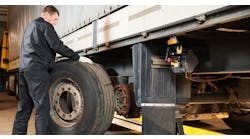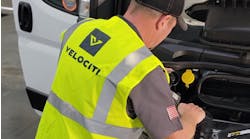Vehicle maintenance shops can pose a number of hazards to those who work there. These include sharp edges, falling objects, flying sparks, chemicals, noise and other potentially dangerous situations.
The Occupational Safety and Health Administration (OSHA) requires that employers protect their employees from workplace hazards – such as machines, shop equipment, work procedures and hazardous substances – that can cause injury.
Because controlling a hazard at its source is the best way to protect workers, OSHA recommends the use of appropriate engineering, work practice and administrative controls to manage or eliminate hazards to the greatest extent possible. However, when these are not feasible or do not provide sufficient protection against hazards, employers must provide personal protective equipment (PPE) to their workers and ensure its use.
PPE includes all clothing and other work accessories designed to create a barrier against workplace hazards to minimize exposure to serious injuries and illnesses.
IDENTIFY HAZARDS
For any PPE program to be most effective, the essential first step, say OSHA officials, is an in-depth evaluation to identify the particular physical and health hazards that are present, or are likely to be present, at the workplace, which would necessitate the use of PPE to protect against them. Every effort should be made to control all hazards, where possible, at the source.
If hazards or the likelihood of hazards are found, employers must select and have affected employees use properly fitted PPE suitable for protection from these hazards.
This hazard assessment – an OSHA requirement – should include a walk-through survey of the workplace, looking for potential hazards in these basic hazard categories:
- Impact.
- Penetration.
- Compression (roll-over).
- Chemical.
- Heat/cold.
- Harmful dust.
- Optical radiation – light, ultraviolet, infrared and reflected light.
The assessment also should include a review of any history of occupational illnesses or injuries.
When the assessment is completed, OSHA officials advise employers to analyze the data to determine the proper types of PPE required to match the hazard, and to be alert for those tasks where multiple protection is needed. They recommend selecting PPE that will provide a level of protection greater than the minimum required to protect workers from hazards.
Employers must select and have affected employees use properly fitted PPE suitable for protection from these hazards.
Further, the officials say the workplace should be reassessed periodically for any changes in conditions, equipment or operating procedures that could affect occupational hazards/illness. This periodic reassessment also should include a review of injury and illness records to spot any trends or areas of concern, and then taking appropriate corrective action.
The suitability of existing PPE, including an evaluation of its condition and age, should be included in the reassessment.
OSHA requires that documentation of the hazard assessment through a written certification that:
- Identifies the workplace evaluated.
- Names the person certifying that the evaluation has been performed.
- Has the date(s) of the hazard assessment.
- Identifies the document as a certification of hazard assessment.
PPE SELECTION
Selection of the proper personal protective equipment for a job is important. Employers and employees must understand the equipment's purpose and its limitations.
All PPE clothing and equipment should be of safe design and construction, and should be maintained in a clean and reliable condition, OSHA officials say. To reduce the possibility of failure, PPE must be properly fitted and must not be altered or removed, even if the employee may find it uncomfortable, which may occur simply because the equipment does not fit properly. When PPE fits well and is comfortable to wear, workers are more likely to use it.
If PPE does not fit properly, it can make the difference between being safely covered or dangerously exposed. The calculated degree of protection will not be achieved in practice unless the PPE is worn properly at all times when the worker is at risk. Furthermore, workers must be aware that PPE does not eliminate the hazard.
Wearing poorly maintained or malfunctioning PPE could be more dangerous than not wearing any form of protection at all. The workers gain a false sense of security and think they are protected when, in reality, they are not.
OSHA requires that many categories of PPE meet or be equivalent to standards developed by the American National Standards Institute. The categories include eye, face, head and foot protection.
REGULAR MAINTENANCE AND INSPECTIONS
An effective system of maintenance of PPE is essential to make sure PPE continues to provide the degree of protection for which it is designed. Maintenance should include inspection, care, cleaning, repair and proper storage.
If carefully performed, inspections will identify damaged or malfunctioning PPE before it is used.
Inspect PPE before each use, say OSHA officials. With most PPE, it only takes a few minutes to inspect the equipment for any breaks, tears and visible signs of stress or damage. Immediately remove any damaged equipment from service until a competent person or a manufacturer’s representative can certify the equipment for use. If not authorized by a manufacturer to repair PPE, do not attempt to fix it.
Procedures should be set up to enable workers to obtain replacement parts for damaged PPE, and to keep it clean.
Where PPE is provided, adequate storage facilities for it must be made available when not in use, unless the employee may take PPE away from the workplace, e.g., footwear or clothing. All PPE must be stored in a clean and sanitary condition ready for use.
TRAINING EMPLOYEES
OSHA requires that employers provide hazard awareness and training to each employee who is required to use PPE so that the worker knows:
- When PPE is necessary.
- What PPE is necessary.
- How to properly put on, adjust and wear PPE.
- The limitations of the PPE in providing protection from hazards.
- The proper care, maintenance, useful life and disposal of PPE.
Workers need to demonstrate an understanding of the training and the ability to use PPE properly before being allowed to perform work requiring its use, say OSHA officials. Circumstances where retraining is required include:
- Changes in the workplace render previous training obsolete.
- Changes in the types of PPE to be used render previous training obsolete.
- Inadequacies in an affected employee's knowledge or use of assigned PPE indicate that the employee has not retained the requisite understanding or skill.
Employers must document the training of each employee required to wear or use PPE by preparing a written certification containing:
- The name of each employee trained.
- The date(s) of training.
- A clear identification of the subject of the certification.
The PPE program should be monitored to ensure its ongoing effectiveness, they stress.
STATE OF MIND
Even with an exceptional PPE program in place, unless the human factors in PPE training are addressed, errors and decisions will be made that will result in injuries, because everyone makes mistakes, says Brody Rutledge, an account manager at SafeStart (safestart.com), an organization that provides safety training.
For the most part, all employees that know the risks, rules and consequences, want to comply and want to go home safely as much as their employers want them to, he says. But the bottom line is when workers are rushing, frustrated, tired or complacent, they are more likely to make an unintentional error, make a poor decision, take a shortcut or simply forget their PPE.
A person’s state of mind greatly influences injuries and PPE compliance, Rutledge explains, because it can:
- Cause a person to make a critical error that increases the risk of an incident occurring in the first place.
- Influence a person’s decision to wear the PPE that is needed to prevent or minimize the severity of an injury when an incident occurs.
THREE OPTIONS
After a traditional PPE program is in place, if employees are failing to comply fully, there are essentially three options, says Rutledge.
- Revise the program by implementing new policies, more monitoring, progressive discipline, etc.
- Purchase new and better PPE.
- Address the human factors that are affecting workers’ PPE decisions.
The first two options will only provide small, incremental improvements in compliance, he says. The biggest improvement opportunity is by addressing the human factors component to PPE compliance.
PERSONAL SAFETY IMPROVEMENT
People can be taught certain skills needed to recognize and manage their state of mind to reduce the risk of making a critical error and improve their critical decisions in real-time, Rutledge maintains. The SafeStart process calls these skills critical error reduction techniques (CERTs), of which there are four:
- Self-trigger on the state of mind or the amount of hazardous energy – any electrical, mechanical, pneumatic, chemical, thermal, gravitational or other energy that can harm people – so a person doesn’t make a critical error.
- Analyze close calls and small errors to prevent agonizing over big ones.
- Look at others for the patterns that increase the risk of injury.
- Work on habits.
Personal safety improvement can be achieved when these skills are incorporated into learning steps to deal with four states of mind that can cause or contribute to some key critical errors, which increase the risk of injury, he explains.
The four states of mind are:
- Rushing.
- Frustration.
- Fatigue.
- Complacency.
The key critical errors are:
- Eyes not on the task.
- Mind not on the task.
- Moving into the line of fire.
- Losing balance, traction and/or grip.
THE GOAL
The goal, says Rutledge, is to help workers:
- Understand how their state of mind affects their safety.
- Give them the motivation and skills to improve and eventually help them build their own personal safety culture where they choose to remember to properly wear their PPE and get in the habit of wearing it everywhere – at work and at home.
In doing this, he adds, workers also will achieve a personal responsibility for PPE compliance that can be shared with their company.




